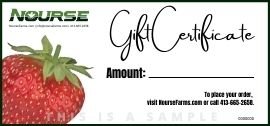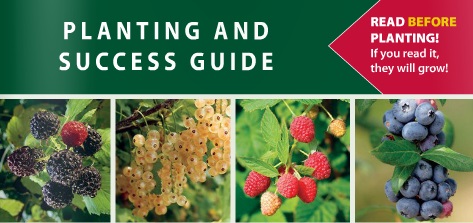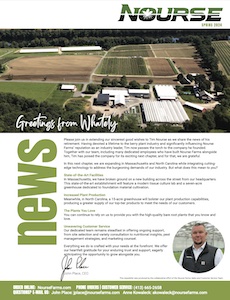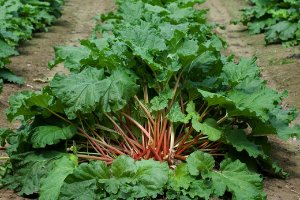What is it?
Rhubarb is easy to grow and makes a wonderful addition to strawberry pie and as the base for many jellies, desserts, sauces, and condiments.
This plant needs cold winter in order to flourish, so the rhubarb crowns we carry at Nourse Farms do well in Zones 4–8.
Important fact
The only edible portion of the rhubarb plant is its stalks. Do not eat the leaves—they are poisonous. Remove at harvest and discard.
Health benefits
Rhubarb is reportedly a good source of vitamin K1, fiber, and antioxidants.
Grow your own
At-A-Glance
Recommended Soil pH: 6.0–6.8
Recommended In-Row Spacing: 3’
Recommended Between Row Spacing: 5–6’
Planting

Do not fertilize close to planting time or during the first season. Plant in the early spring, in well-prepared, weed-free soil. To increase organic matter, work 2–3” of aged compost into the top 6–8” of soil well in advance of planting. Good drainage is absolutely necessary. If you have heavy or slowly draining soil, you must plant rhubarb in raised beds. Set divisions in the ground so the buds are positioned ½” below the soil surface, pointing up. You will find the buds nestled in a protective layer of dark papery husks. When planting, be sure there are no air pockets beneath the division and press the soil firmly around and over the division to eliminate air pockets. Be careful not to break the buds.
Fertilization
Fertilizer requirements are best determined by a soil test, but a general recommendation is to add an inch or so of well-aged compost early each spring or 1–1.5 lb. 10-10-10 fertilizer per 100 square feet. It would be best to divide that amount of fertilizer into two to three applications during the spring and summer with the first application before new growth starts. Do not fertilize after July 1, late fertilization generates tender new growth which will be more susceptible to winter injury. Check your pH and fertility every two to three years.
Harvesting
Do not harvest rhubarb the first year. Harvest lightly (a few stalks per plant) the second year. The third year, you may harvest stalks that are 1” and larger in diameter for a period of six to eight weeks. As stems get shorter and thinner, stop harvesting for the season. Leave remaining stalks to make food for the crown and next year’s production. Harvest by holding the stalk near the base and use a pulling and twisting motion to snap the stalk at the base. You may use a sharp knife to cut stalks. Cut as close to the base as possible without damaging the crown. Remove the leaf and the base of the stalk before storing. Remember: Do not eat the leaves as they are poisonous. Only harvest about 1/3–1/2 of the stalks at one time for each plant. Though some harvesting in the fall is acceptable, rhubarb is typically harvested from early May to early June.
Maintenance
Seed stalks that develop should be snapped off immediately. To maintain stalk size and productivity, divide plants after four to five years. Dig when plants are dormant, in early spring and take care not to damage the buds while cutting or replanting. Divide the roots of the most vigorous plants into pieces about 2” wide, being sure each piece has good bud development. Use these to establish your new bed. Follow the planting instructions above.
Order your rhubarb crowns from Nourse Farms today.




